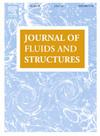Stability analysis of an articulated flexible pipe conveying fluid with a rotational spring
IF 3.4
2区 工程技术
Q1 ENGINEERING, MECHANICAL
引用次数: 0
Abstract
The stability of an articulated flexible pipe conveying fluid by altering its structural parameters is investigated in this paper. Utilizing generalized Hamilton's principle, the governing equations for the motion of both the upper and lower pipe segments of the system are established. The equations are then discretized using the Galerkin's method, which leads to a generalized eigenvalue problem. To validate the mathematical model, the eigenvalue branches of a degenerated system are compared with prior findings by using extreme values for the structural parameters. The results indicate that the instability characteristics of the pipe system are heavily influenced by these parameters. A reduction in the length of the upper segment causes the system to exhibit characteristics similar to either a pinned-free or cantilevered pipe, contingent upon the stiffness of the rotational spring. Secondary flutter phenomena manifest after the third or fourth mode instability as the flow velocity increases. When the upper and lower segments are of equal lengths, the critical flow velocity stabilizes when the spring stiffness surpasses a certain threshold. The inclusion of a flexible joint between the segments increases the system's susceptibility to higher-mode instability. Additionally, an extended upper segment may result in intricate instability behaviors, including a sequence of “instability-restabilization-instability” as the flow velocity rises. These innovative numerical findings provide theoretical perspectives on the dynamic behavior of articulated fluid-conveying pipes.
带旋转弹簧的铰接输送流体柔性管的稳定性分析
本文研究了改变铰接柔性管道结构参数对其输送流体稳定性的影响。利用广义汉密尔顿原理,建立了系统上下管段运动的控制方程。然后用伽辽金方法将方程离散,得到一个广义特征值问题。为了验证数学模型,通过使用结构参数的极值将退化系统的特征值分支与先前的发现进行比较。结果表明,这些参数对管道系统的失稳特性影响很大。减少上部段的长度使系统表现出类似于无钉管或悬臂管的特性,这取决于旋转弹簧的刚度。随着流速的增加,在第三或第四模态失稳后出现二次颤振现象。当上下段长度相等时,当弹簧刚度超过一定阈值时,临界流速趋于稳定。在节段之间包含一个柔性关节增加了系统对高模态不稳定性的敏感性。此外,上段的延长可能导致复杂的不稳定行为,包括随着流速的增加而出现的“不稳定-再稳定-不稳定”的序列。这些创新的数值结果为铰接流体输送管的动力学行为提供了理论视角。
本文章由计算机程序翻译,如有差异,请以英文原文为准。
求助全文
约1分钟内获得全文
求助全文
来源期刊

Journal of Fluids and Structures
工程技术-工程:机械
CiteScore
6.90
自引率
8.30%
发文量
173
审稿时长
65 days
期刊介绍:
The Journal of Fluids and Structures serves as a focal point and a forum for the exchange of ideas, for the many kinds of specialists and practitioners concerned with fluid–structure interactions and the dynamics of systems related thereto, in any field. One of its aims is to foster the cross–fertilization of ideas, methods and techniques in the various disciplines involved.
The journal publishes papers that present original and significant contributions on all aspects of the mechanical interactions between fluids and solids, regardless of scale.
 求助内容:
求助内容: 应助结果提醒方式:
应助结果提醒方式:


